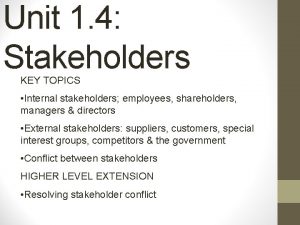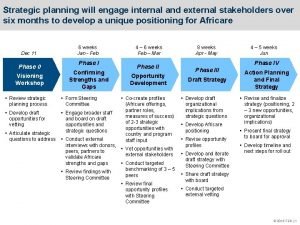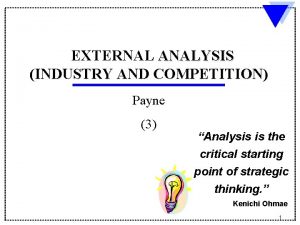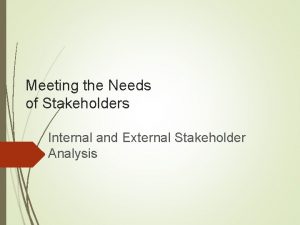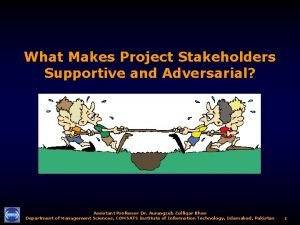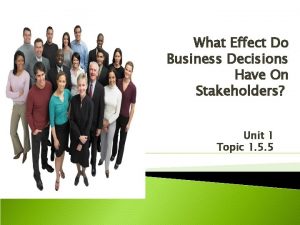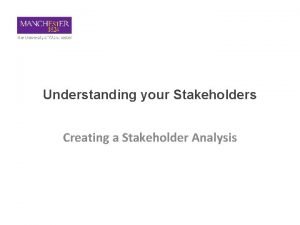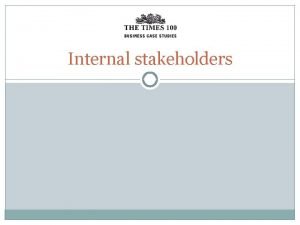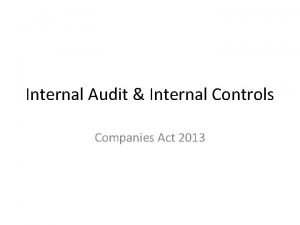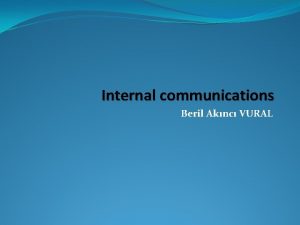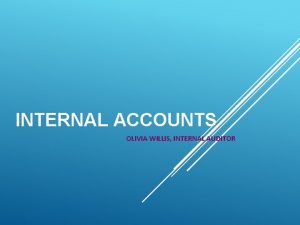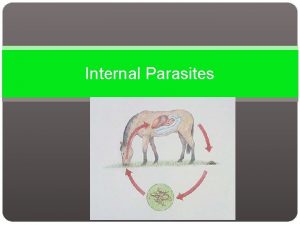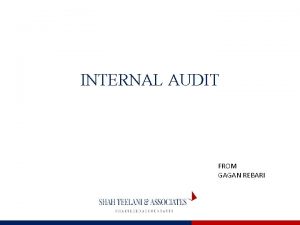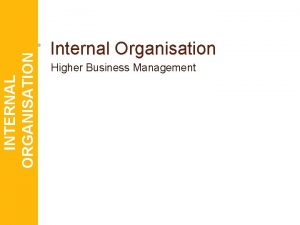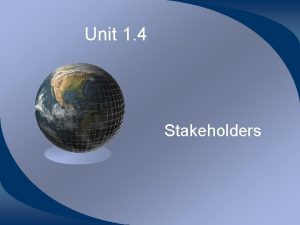Unit 1 4 Stakeholders KEY TOPICS Internal stakeholders















- Slides: 15

Unit 1. 4: Stakeholders KEY TOPICS • Internal stakeholders; employees, shareholders, managers & directors • External stakeholders: suppliers, customers, special interest groups, competitors & the government • Conflict between stakeholders HIGHER LEVEL EXTENSION • Resolving stakeholder conflict

Stakeholders: person or organization that has a direct interest in & is affected by the performance of a business. § Ex: owners, managers, employees, customers, suppliers, investors, competitors, the local community and the government. § Internal stakeholders: members of the organization (employees, shareholders, managers & directors). § External stakeholders: do not form part of the business (customers, suppliers & the government).

Internal stakeholders n Employees: strive to improve pay & financial benefits; working conditions, job security, training & career progression opportunities. n Shareholders: owners of private and public limited companies. n n n They invest their money by purchasing shares as they expect the company to generate a healthy return on their investment. Main objectives: to maximize share dividend payments, achieve a rise in the value of the capital gains. Managers & directors: people who plan, organize and control the daily running of the business. n Aim to maximize their own benefits by profit maximization and to retain profits for further investments.

External stakeholders § Suppliers: provide a business with stocks of raw materials, component parts, finished goods and other resources needed for production. § Aim for regular contracts with clients at good prices and request that customers pay their outstanding bills on time. § Customers: determines the financial performance of a business. § May demand more choice of better quality products at competitive prices & a pleasant and efficient purchasing experience.

Special interest groups: organization that advocates certain issues (prevention of cruelty to animals, protection of the environment or prevention of smoking in public areas). § Trade Unions/Labor Unions: aim to uphold & enhance the conditions of work for their members. They campaign for: § Wages and salaries to rise in line with inflation. § Introduction of a minimum wage to improve the earnings of those on low incomes. § Better working conditions. § Pressure Groups: seek to place demands on organizations to act in a particular way or to influence a change in their behavior (PETA, Greenpeace, Friends of the Earth). Actions taken: boycotting, lobbying, direct action. § Industry Trade Groups: organizations that specialize in public relations with the aim of promoting a particular industry, through education and advertising. Funded by the businesses that operate in a particular industry.

Special interest groups are more likely to succeed in achieving their aims & objectives if certain interrelated factors are accomplished: • Funding: financial resources, more money=greater influence. • Public Opinion: greater support= greater influence on the actions of businesses. • Number of Members: More active members= more influence on government and business activity. • Commitment of Members: United group=strengthened ability to influence business behavior.

Competitors: the rival businesses of an organization. • Competitors will be interested in the activities of a business for several reasons, including: 1. To avoid anti-competitive practices of rival firms. Larger firms may wish to exploit their monopoly power, although this may be restricted by government intervention. 2. As a stimulus to innovation and product development. Firms may benefit from some competition as rivalry can lead to more ideas being generated.

Government: important stakeholder that is likely to have a large influence on business behaviour. • The government will be interested in business activity for several reasons, including assurances that: • Unfair business practices are avoided. • Health & safety standards at work are met. • The correct amount of corporation tax is paid from business profits. • Payment of business rates are adhered to. • Consumer protection laws are observed & followed. • Employment legislation is being upheld by the organization. • May also have a financial stake in a business organization. • Aims to ensure that businesses act in the public’s interest.

Stakeholder Conflict • Conflict arises because the business cannot necessarily meet the needs of all its stakeholders simultaneously. • A major cause of conflict is the pay & remuneration of the directors of a company. • Also, some stakeholders have more than one interest in an organization. • It is argued that meeting the needs of all stakeholder groups can be achieved, although this may only occur in the medium to long term.

Resolving Stakeholder Conflict (higher level extension). • The outcome of any negotiation will depend largely on the relative bargaining power of the different stakeholders. • It’s unlikely that a business can fulfill the aims of all its stakeholders at the same time; yet it’s undesirable to maximize the needs of just one stakeholder group. • If a particular stakeholder group isn’t catered for, it is likely that they’ll cause problems for the business. • Most businesses will aim for a “best-fit” compromise so that stakeholder groups are all reasonably pleased with the decision of the business.

Stakeholder Mapping Model • Created by Johnson & Scholes. • Can be used to asses the relative interest of stakeholders in a business & their relative power on business behaviour. Level of interest Level of power Low High Low A B High C D • Allows managers to assess how to deal with conflicting stakeholder objectives & prioritize their actions. • Managers can use to prioritize their actions. • Stakeholders in quadrant D are the key players of an organization. • Limitation: the model is static. The relative power/level of interest of stakeholders is likely to change with time.

Public Relations • Another way to deal with stakeholder conflicts by employing a good public relations firm. • PR specialists have the expertise to handle negative publicity. • Communications are also very important in encouraging good PR. • Firms can reduce the chances of conflict occurring by fully involving their stakeholders, such as employees and the local community, and by keeping them up to date and informed about decision made by the business.

Stakeholders and business strategy • In deciding how to deal with conflicting stakeholder needs, leaders will need to look at three key issues: 1. The type of business organization in question. 2. The aims and objectives of the business. 3. The source and degree of power of each stakeholder group.

Terms • Conflict: situations where people have disagreements on certain matters due to differences in their opinions. • Directors: senior members of staff who have been elected by shareholders of a company to run the business on their behalf. • External stakeholders: do not form part of the organization but have a direct interest or involvement in the actions of the organization. • Internal stakeholders: members of the organization. • Managers: the people responsible for the day to day running of a business or a department within a business. • Pressure groups: type of SIG which consists of individuals with a common concern who seek to place demands on organizations to act in a particular way or to influence a change in their behavior. • Shareholders: people who own shares in a private or public limited company. • Special interest group: the organization of people who have a common interest and collectively act to achieve that interest. • Stakeholder mapping: tool which places different stakeholder groups into quadrants depending on their relative levels of power and interest in an organization. • Stakeholders: individuals or organizations that have a direct interest in the activities and performance of a business.

Review Questions 1. Using examples, explain the difference between “internal” and “external” stakeholders. 2. What is the difference between “stakeholders” and “shareholders”? 3. Distinguish between “director” and a “shareholder” of a company. 4. What are the four main types of special interest groups? 5. Differentiate between “lobbying” and “boycotting”. 6. How might pressure groups affect the success of a business? 7. Outline four sources of conflict in a business. HIGHER LEVEL EXTENSION 1. How might businesses resolve conflict in the workplace? 2. Explain how the use of Johnson and Scholes’s stakeholder mapping tool can be used to aid management decision-making.
 Internal and external stakeholders examples
Internal and external stakeholders examples Internal vs external stakeholders
Internal vs external stakeholders Internal stakeholers
Internal stakeholers Internal stakeholders examples
Internal stakeholders examples Stakeholders internal and external
Stakeholders internal and external Example of a business model canvas
Example of a business model canvas Key partners
Key partners Key topics
Key topics What topics will be covered in this unit
What topics will be covered in this unit Unit 10, unit 10 review tests, unit 10 general test
Unit 10, unit 10 review tests, unit 10 general test Difference between internal check and internal control
Difference between internal check and internal control Vouching in auditing
Vouching in auditing Adversarial stakeholders
Adversarial stakeholders Primary and secondary stakeholders
Primary and secondary stakeholders Understanding your stakeholders
Understanding your stakeholders C level stakeholders
C level stakeholders
